Eating Disorders: Multidisciplinary Assessment and Interventions
VerifiedAdded on 2023/05/30
|11
|2953
|263
AI Summary
This paper discusses the multidisciplinary assessment and intervention measures for eating disorders in young people and their families. It explores the different types of eating disorders, their symptoms, and the physical and psychological consequences of these disorders. The assessment involves gauging the history of the eating disorder, mental status, physical examination, and family and social history. The intervention measures include psychotherapy, nutritional education, in-patient treatment, medications, and family-based therapy.
Contribute Materials
Your contribution can guide someone’s learning journey. Share your
documents today.
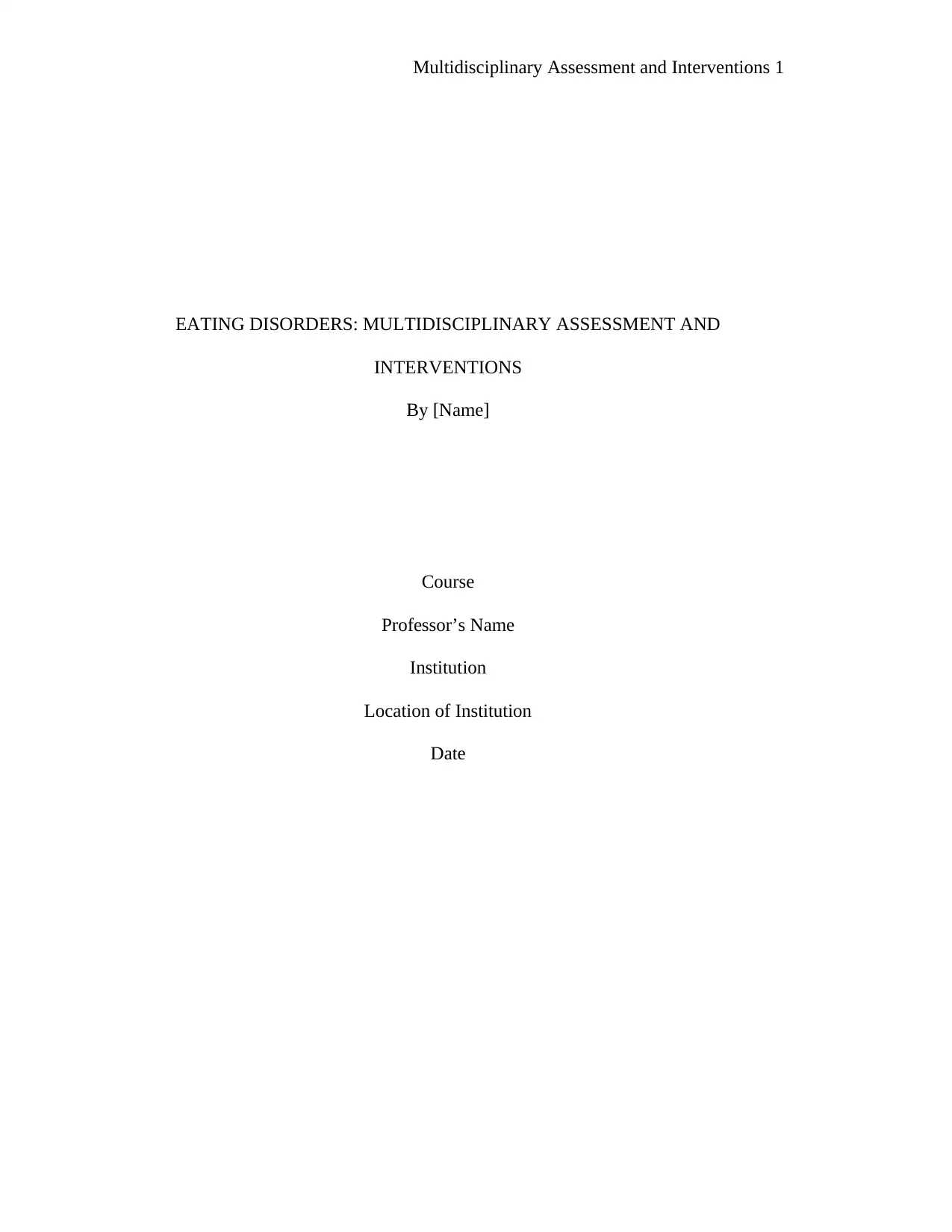
Multidisciplinary Assessment and Interventions 1
EATING DISORDERS: MULTIDISCIPLINARY ASSESSMENT AND
INTERVENTIONS
By [Name]
Course
Professor’s Name
Institution
Location of Institution
Date
EATING DISORDERS: MULTIDISCIPLINARY ASSESSMENT AND
INTERVENTIONS
By [Name]
Course
Professor’s Name
Institution
Location of Institution
Date
Secure Best Marks with AI Grader
Need help grading? Try our AI Grader for instant feedback on your assignments.
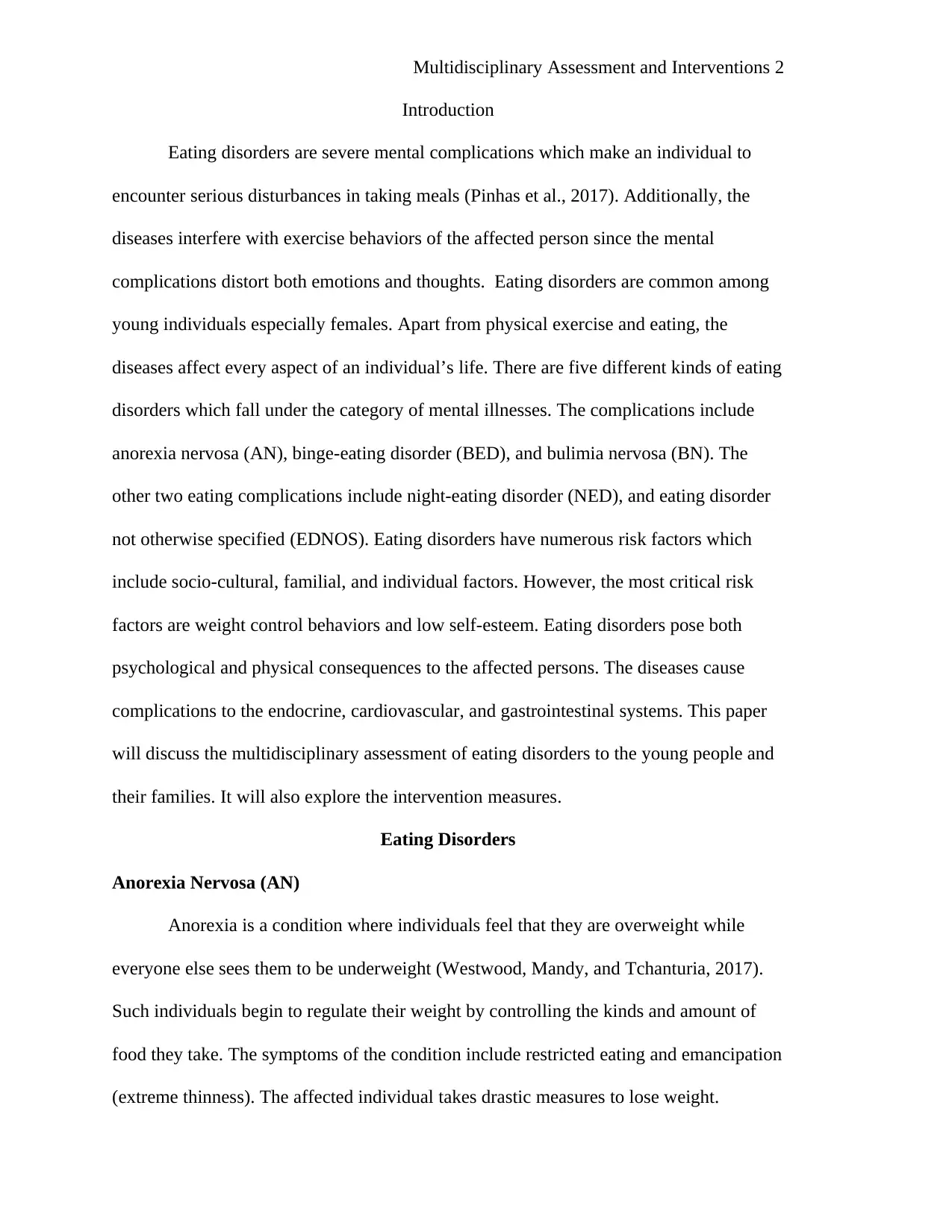
Multidisciplinary Assessment and Interventions 2
Introduction
Eating disorders are severe mental complications which make an individual to
encounter serious disturbances in taking meals (Pinhas et al., 2017). Additionally, the
diseases interfere with exercise behaviors of the affected person since the mental
complications distort both emotions and thoughts. Eating disorders are common among
young individuals especially females. Apart from physical exercise and eating, the
diseases affect every aspect of an individual’s life. There are five different kinds of eating
disorders which fall under the category of mental illnesses. The complications include
anorexia nervosa (AN), binge-eating disorder (BED), and bulimia nervosa (BN). The
other two eating complications include night-eating disorder (NED), and eating disorder
not otherwise specified (EDNOS). Eating disorders have numerous risk factors which
include socio-cultural, familial, and individual factors. However, the most critical risk
factors are weight control behaviors and low self-esteem. Eating disorders pose both
psychological and physical consequences to the affected persons. The diseases cause
complications to the endocrine, cardiovascular, and gastrointestinal systems. This paper
will discuss the multidisciplinary assessment of eating disorders to the young people and
their families. It will also explore the intervention measures.
Eating Disorders
Anorexia Nervosa (AN)
Anorexia is a condition where individuals feel that they are overweight while
everyone else sees them to be underweight (Westwood, Mandy, and Tchanturia, 2017).
Such individuals begin to regulate their weight by controlling the kinds and amount of
food they take. The symptoms of the condition include restricted eating and emancipation
(extreme thinness). The affected individual takes drastic measures to lose weight.
Introduction
Eating disorders are severe mental complications which make an individual to
encounter serious disturbances in taking meals (Pinhas et al., 2017). Additionally, the
diseases interfere with exercise behaviors of the affected person since the mental
complications distort both emotions and thoughts. Eating disorders are common among
young individuals especially females. Apart from physical exercise and eating, the
diseases affect every aspect of an individual’s life. There are five different kinds of eating
disorders which fall under the category of mental illnesses. The complications include
anorexia nervosa (AN), binge-eating disorder (BED), and bulimia nervosa (BN). The
other two eating complications include night-eating disorder (NED), and eating disorder
not otherwise specified (EDNOS). Eating disorders have numerous risk factors which
include socio-cultural, familial, and individual factors. However, the most critical risk
factors are weight control behaviors and low self-esteem. Eating disorders pose both
psychological and physical consequences to the affected persons. The diseases cause
complications to the endocrine, cardiovascular, and gastrointestinal systems. This paper
will discuss the multidisciplinary assessment of eating disorders to the young people and
their families. It will also explore the intervention measures.
Eating Disorders
Anorexia Nervosa (AN)
Anorexia is a condition where individuals feel that they are overweight while
everyone else sees them to be underweight (Westwood, Mandy, and Tchanturia, 2017).
Such individuals begin to regulate their weight by controlling the kinds and amount of
food they take. The symptoms of the condition include restricted eating and emancipation
(extreme thinness). The affected individual takes drastic measures to lose weight.
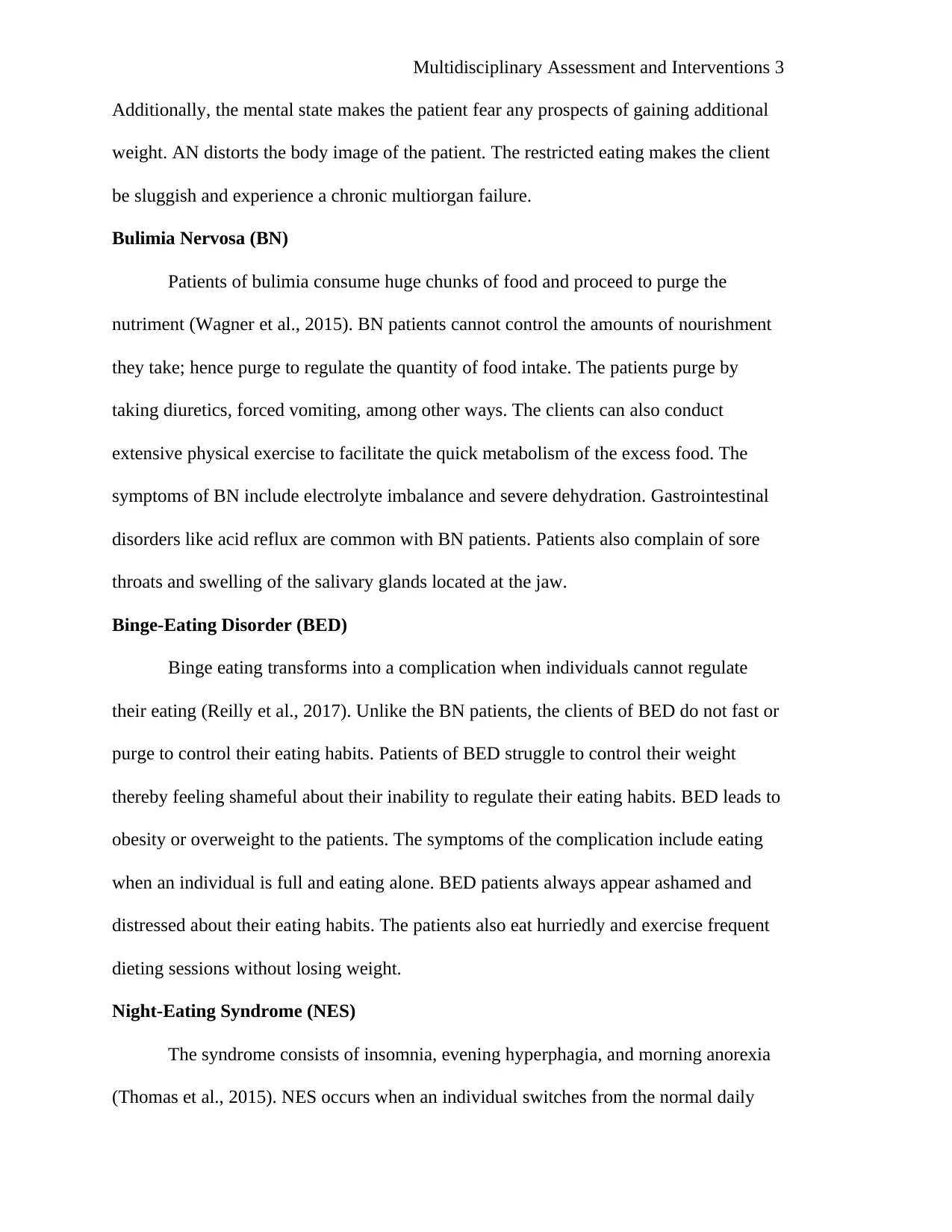
Multidisciplinary Assessment and Interventions 3
Additionally, the mental state makes the patient fear any prospects of gaining additional
weight. AN distorts the body image of the patient. The restricted eating makes the client
be sluggish and experience a chronic multiorgan failure.
Bulimia Nervosa (BN)
Patients of bulimia consume huge chunks of food and proceed to purge the
nutriment (Wagner et al., 2015). BN patients cannot control the amounts of nourishment
they take; hence purge to regulate the quantity of food intake. The patients purge by
taking diuretics, forced vomiting, among other ways. The clients can also conduct
extensive physical exercise to facilitate the quick metabolism of the excess food. The
symptoms of BN include electrolyte imbalance and severe dehydration. Gastrointestinal
disorders like acid reflux are common with BN patients. Patients also complain of sore
throats and swelling of the salivary glands located at the jaw.
Binge-Eating Disorder (BED)
Binge eating transforms into a complication when individuals cannot regulate
their eating (Reilly et al., 2017). Unlike the BN patients, the clients of BED do not fast or
purge to control their eating habits. Patients of BED struggle to control their weight
thereby feeling shameful about their inability to regulate their eating habits. BED leads to
obesity or overweight to the patients. The symptoms of the complication include eating
when an individual is full and eating alone. BED patients always appear ashamed and
distressed about their eating habits. The patients also eat hurriedly and exercise frequent
dieting sessions without losing weight.
Night-Eating Syndrome (NES)
The syndrome consists of insomnia, evening hyperphagia, and morning anorexia
(Thomas et al., 2015). NES occurs when an individual switches from the normal daily
Additionally, the mental state makes the patient fear any prospects of gaining additional
weight. AN distorts the body image of the patient. The restricted eating makes the client
be sluggish and experience a chronic multiorgan failure.
Bulimia Nervosa (BN)
Patients of bulimia consume huge chunks of food and proceed to purge the
nutriment (Wagner et al., 2015). BN patients cannot control the amounts of nourishment
they take; hence purge to regulate the quantity of food intake. The patients purge by
taking diuretics, forced vomiting, among other ways. The clients can also conduct
extensive physical exercise to facilitate the quick metabolism of the excess food. The
symptoms of BN include electrolyte imbalance and severe dehydration. Gastrointestinal
disorders like acid reflux are common with BN patients. Patients also complain of sore
throats and swelling of the salivary glands located at the jaw.
Binge-Eating Disorder (BED)
Binge eating transforms into a complication when individuals cannot regulate
their eating (Reilly et al., 2017). Unlike the BN patients, the clients of BED do not fast or
purge to control their eating habits. Patients of BED struggle to control their weight
thereby feeling shameful about their inability to regulate their eating habits. BED leads to
obesity or overweight to the patients. The symptoms of the complication include eating
when an individual is full and eating alone. BED patients always appear ashamed and
distressed about their eating habits. The patients also eat hurriedly and exercise frequent
dieting sessions without losing weight.
Night-Eating Syndrome (NES)
The syndrome consists of insomnia, evening hyperphagia, and morning anorexia
(Thomas et al., 2015). NES occurs when an individual switches from the normal daily
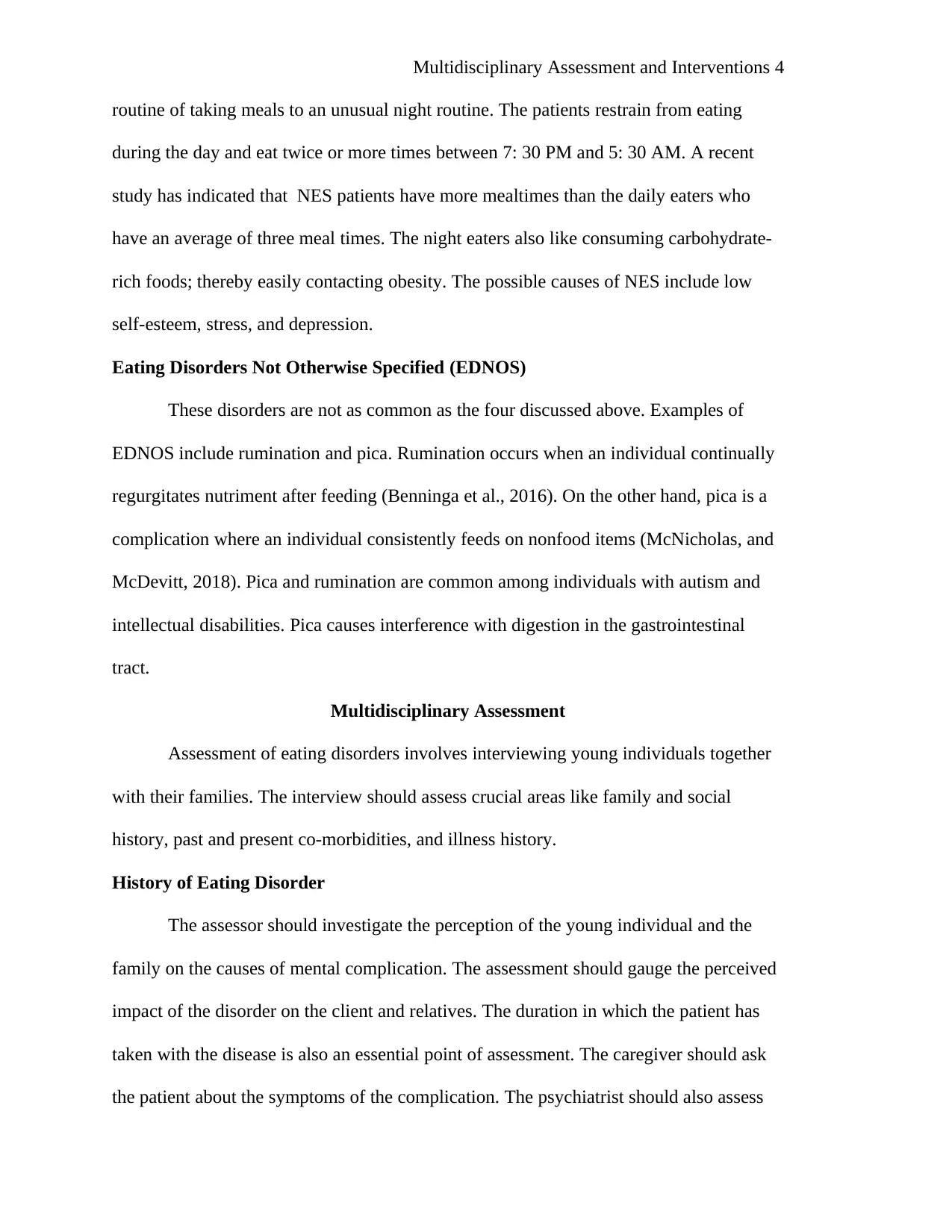
Multidisciplinary Assessment and Interventions 4
routine of taking meals to an unusual night routine. The patients restrain from eating
during the day and eat twice or more times between 7: 30 PM and 5: 30 AM. A recent
study has indicated that NES patients have more mealtimes than the daily eaters who
have an average of three meal times. The night eaters also like consuming carbohydrate-
rich foods; thereby easily contacting obesity. The possible causes of NES include low
self-esteem, stress, and depression.
Eating Disorders Not Otherwise Specified (EDNOS)
These disorders are not as common as the four discussed above. Examples of
EDNOS include rumination and pica. Rumination occurs when an individual continually
regurgitates nutriment after feeding (Benninga et al., 2016). On the other hand, pica is a
complication where an individual consistently feeds on nonfood items (McNicholas, and
McDevitt, 2018). Pica and rumination are common among individuals with autism and
intellectual disabilities. Pica causes interference with digestion in the gastrointestinal
tract.
Multidisciplinary Assessment
Assessment of eating disorders involves interviewing young individuals together
with their families. The interview should assess crucial areas like family and social
history, past and present co-morbidities, and illness history.
History of Eating Disorder
The assessor should investigate the perception of the young individual and the
family on the causes of mental complication. The assessment should gauge the perceived
impact of the disorder on the client and relatives. The duration in which the patient has
taken with the disease is also an essential point of assessment. The caregiver should ask
the patient about the symptoms of the complication. The psychiatrist should also assess
routine of taking meals to an unusual night routine. The patients restrain from eating
during the day and eat twice or more times between 7: 30 PM and 5: 30 AM. A recent
study has indicated that NES patients have more mealtimes than the daily eaters who
have an average of three meal times. The night eaters also like consuming carbohydrate-
rich foods; thereby easily contacting obesity. The possible causes of NES include low
self-esteem, stress, and depression.
Eating Disorders Not Otherwise Specified (EDNOS)
These disorders are not as common as the four discussed above. Examples of
EDNOS include rumination and pica. Rumination occurs when an individual continually
regurgitates nutriment after feeding (Benninga et al., 2016). On the other hand, pica is a
complication where an individual consistently feeds on nonfood items (McNicholas, and
McDevitt, 2018). Pica and rumination are common among individuals with autism and
intellectual disabilities. Pica causes interference with digestion in the gastrointestinal
tract.
Multidisciplinary Assessment
Assessment of eating disorders involves interviewing young individuals together
with their families. The interview should assess crucial areas like family and social
history, past and present co-morbidities, and illness history.
History of Eating Disorder
The assessor should investigate the perception of the young individual and the
family on the causes of mental complication. The assessment should gauge the perceived
impact of the disorder on the client and relatives. The duration in which the patient has
taken with the disease is also an essential point of assessment. The caregiver should ask
the patient about the symptoms of the complication. The psychiatrist should also assess
Paraphrase This Document
Need a fresh take? Get an instant paraphrase of this document with our AI Paraphraser
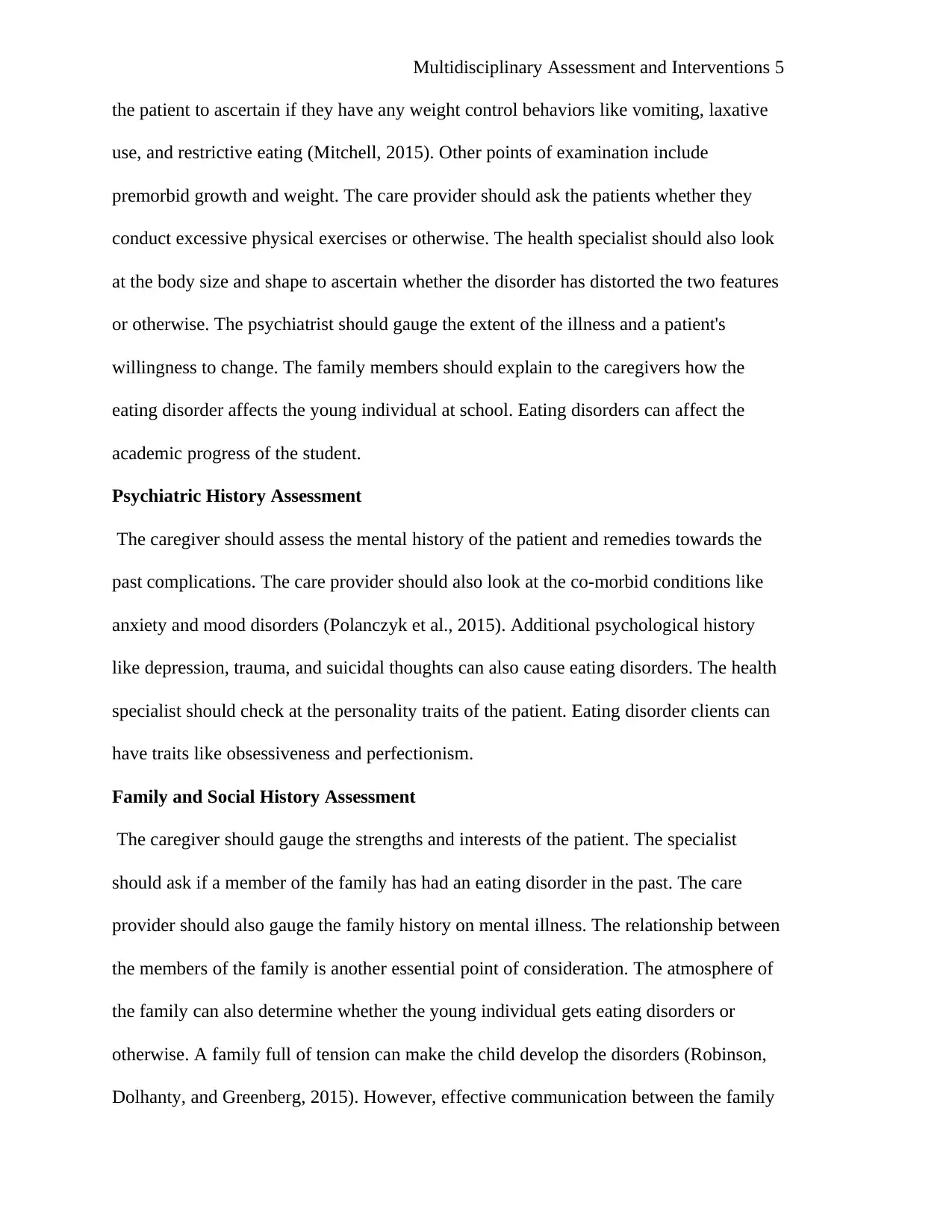
Multidisciplinary Assessment and Interventions 5
the patient to ascertain if they have any weight control behaviors like vomiting, laxative
use, and restrictive eating (Mitchell, 2015). Other points of examination include
premorbid growth and weight. The care provider should ask the patients whether they
conduct excessive physical exercises or otherwise. The health specialist should also look
at the body size and shape to ascertain whether the disorder has distorted the two features
or otherwise. The psychiatrist should gauge the extent of the illness and a patient's
willingness to change. The family members should explain to the caregivers how the
eating disorder affects the young individual at school. Eating disorders can affect the
academic progress of the student.
Psychiatric History Assessment
The caregiver should assess the mental history of the patient and remedies towards the
past complications. The care provider should also look at the co-morbid conditions like
anxiety and mood disorders (Polanczyk et al., 2015). Additional psychological history
like depression, trauma, and suicidal thoughts can also cause eating disorders. The health
specialist should check at the personality traits of the patient. Eating disorder clients can
have traits like obsessiveness and perfectionism.
Family and Social History Assessment
The caregiver should gauge the strengths and interests of the patient. The specialist
should ask if a member of the family has had an eating disorder in the past. The care
provider should also gauge the family history on mental illness. The relationship between
the members of the family is another essential point of consideration. The atmosphere of
the family can also determine whether the young individual gets eating disorders or
otherwise. A family full of tension can make the child develop the disorders (Robinson,
Dolhanty, and Greenberg, 2015). However, effective communication between the family
the patient to ascertain if they have any weight control behaviors like vomiting, laxative
use, and restrictive eating (Mitchell, 2015). Other points of examination include
premorbid growth and weight. The care provider should ask the patients whether they
conduct excessive physical exercises or otherwise. The health specialist should also look
at the body size and shape to ascertain whether the disorder has distorted the two features
or otherwise. The psychiatrist should gauge the extent of the illness and a patient's
willingness to change. The family members should explain to the caregivers how the
eating disorder affects the young individual at school. Eating disorders can affect the
academic progress of the student.
Psychiatric History Assessment
The caregiver should assess the mental history of the patient and remedies towards the
past complications. The care provider should also look at the co-morbid conditions like
anxiety and mood disorders (Polanczyk et al., 2015). Additional psychological history
like depression, trauma, and suicidal thoughts can also cause eating disorders. The health
specialist should check at the personality traits of the patient. Eating disorder clients can
have traits like obsessiveness and perfectionism.
Family and Social History Assessment
The caregiver should gauge the strengths and interests of the patient. The specialist
should ask if a member of the family has had an eating disorder in the past. The care
provider should also gauge the family history on mental illness. The relationship between
the members of the family is another essential point of consideration. The atmosphere of
the family can also determine whether the young individual gets eating disorders or
otherwise. A family full of tension can make the child develop the disorders (Robinson,
Dolhanty, and Greenberg, 2015). However, effective communication between the family
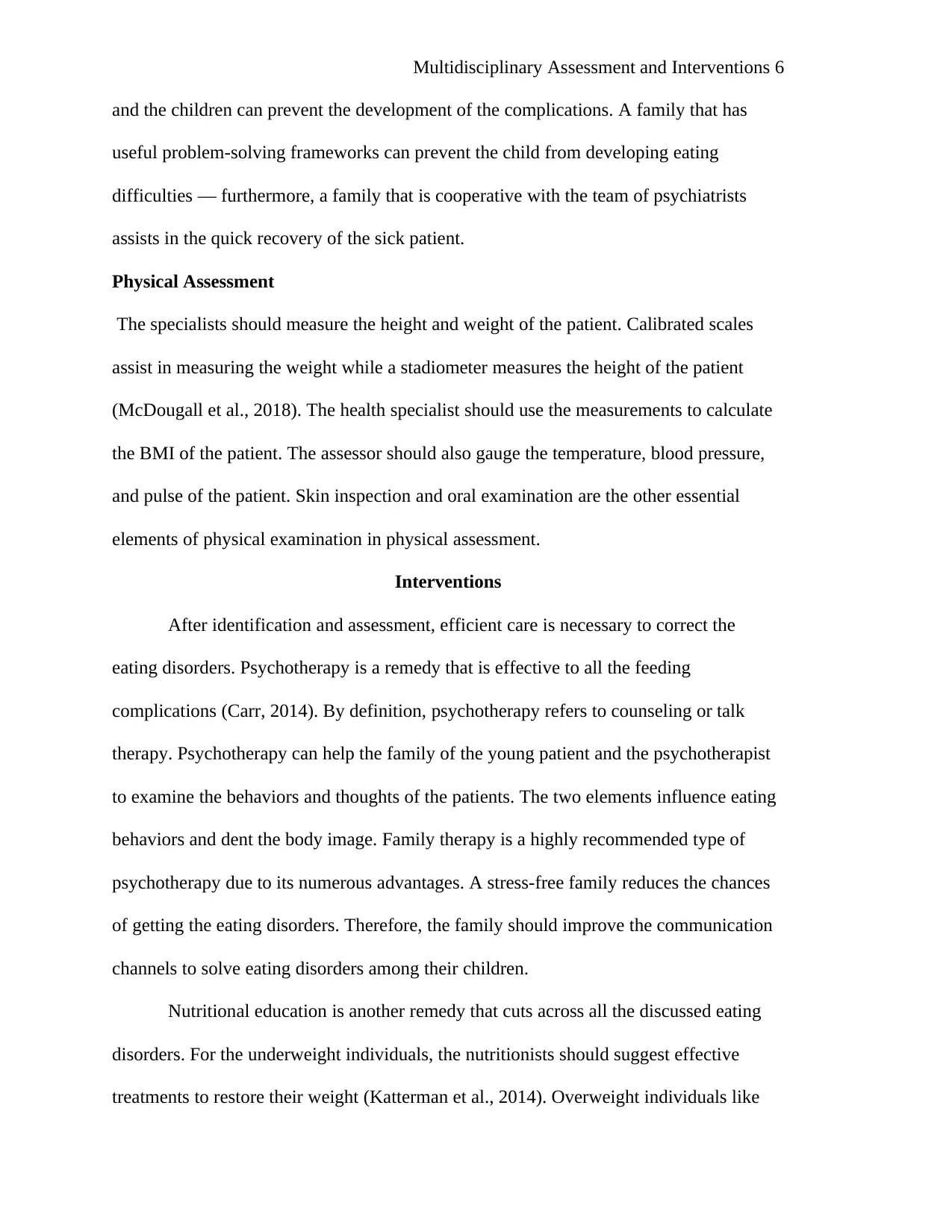
Multidisciplinary Assessment and Interventions 6
and the children can prevent the development of the complications. A family that has
useful problem-solving frameworks can prevent the child from developing eating
difficulties — furthermore, a family that is cooperative with the team of psychiatrists
assists in the quick recovery of the sick patient.
Physical Assessment
The specialists should measure the height and weight of the patient. Calibrated scales
assist in measuring the weight while a stadiometer measures the height of the patient
(McDougall et al., 2018). The health specialist should use the measurements to calculate
the BMI of the patient. The assessor should also gauge the temperature, blood pressure,
and pulse of the patient. Skin inspection and oral examination are the other essential
elements of physical examination in physical assessment.
Interventions
After identification and assessment, efficient care is necessary to correct the
eating disorders. Psychotherapy is a remedy that is effective to all the feeding
complications (Carr, 2014). By definition, psychotherapy refers to counseling or talk
therapy. Psychotherapy can help the family of the young patient and the psychotherapist
to examine the behaviors and thoughts of the patients. The two elements influence eating
behaviors and dent the body image. Family therapy is a highly recommended type of
psychotherapy due to its numerous advantages. A stress-free family reduces the chances
of getting the eating disorders. Therefore, the family should improve the communication
channels to solve eating disorders among their children.
Nutritional education is another remedy that cuts across all the discussed eating
disorders. For the underweight individuals, the nutritionists should suggest effective
treatments to restore their weight (Katterman et al., 2014). Overweight individuals like
and the children can prevent the development of the complications. A family that has
useful problem-solving frameworks can prevent the child from developing eating
difficulties — furthermore, a family that is cooperative with the team of psychiatrists
assists in the quick recovery of the sick patient.
Physical Assessment
The specialists should measure the height and weight of the patient. Calibrated scales
assist in measuring the weight while a stadiometer measures the height of the patient
(McDougall et al., 2018). The health specialist should use the measurements to calculate
the BMI of the patient. The assessor should also gauge the temperature, blood pressure,
and pulse of the patient. Skin inspection and oral examination are the other essential
elements of physical examination in physical assessment.
Interventions
After identification and assessment, efficient care is necessary to correct the
eating disorders. Psychotherapy is a remedy that is effective to all the feeding
complications (Carr, 2014). By definition, psychotherapy refers to counseling or talk
therapy. Psychotherapy can help the family of the young patient and the psychotherapist
to examine the behaviors and thoughts of the patients. The two elements influence eating
behaviors and dent the body image. Family therapy is a highly recommended type of
psychotherapy due to its numerous advantages. A stress-free family reduces the chances
of getting the eating disorders. Therefore, the family should improve the communication
channels to solve eating disorders among their children.
Nutritional education is another remedy that cuts across all the discussed eating
disorders. For the underweight individuals, the nutritionists should suggest effective
treatments to restore their weight (Katterman et al., 2014). Overweight individuals like
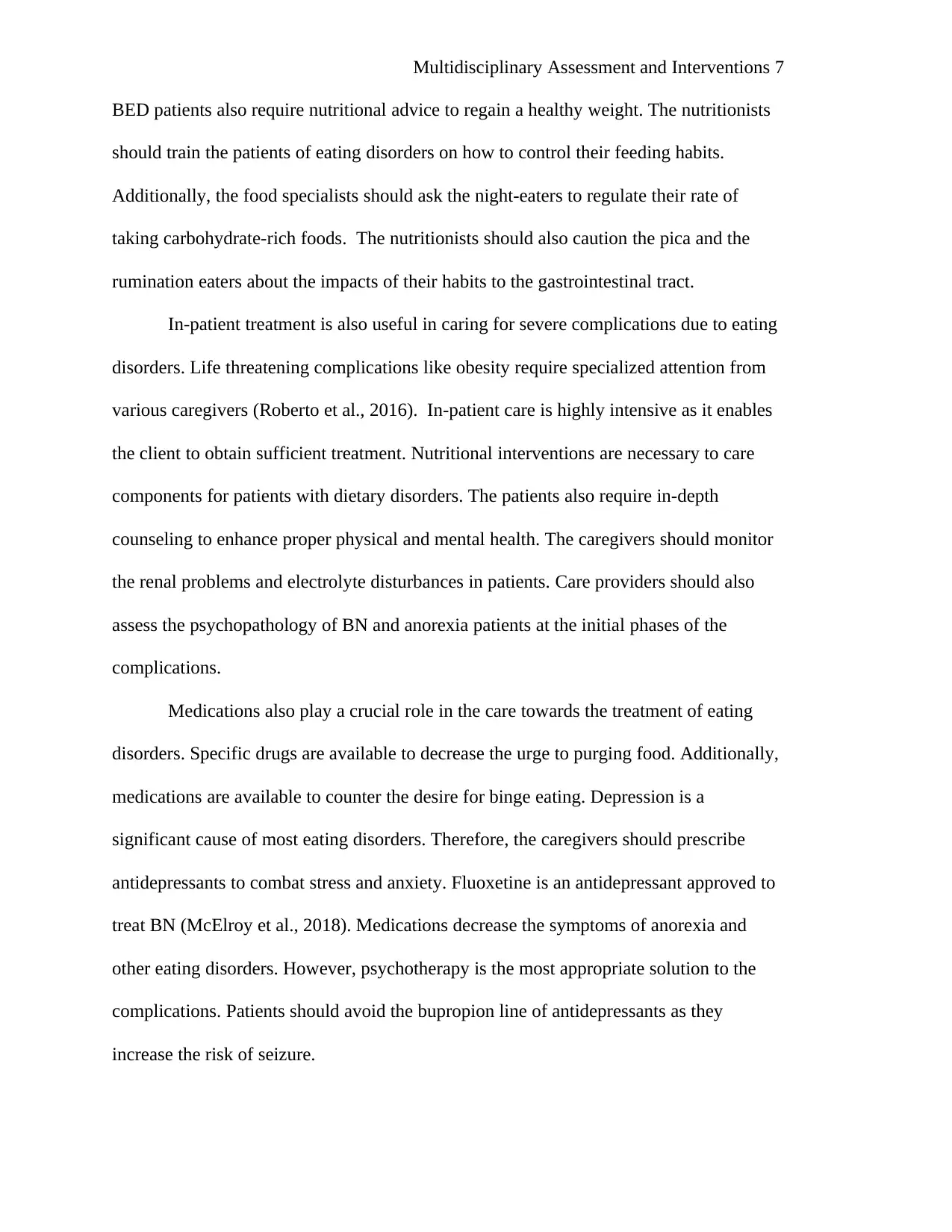
Multidisciplinary Assessment and Interventions 7
BED patients also require nutritional advice to regain a healthy weight. The nutritionists
should train the patients of eating disorders on how to control their feeding habits.
Additionally, the food specialists should ask the night-eaters to regulate their rate of
taking carbohydrate-rich foods. The nutritionists should also caution the pica and the
rumination eaters about the impacts of their habits to the gastrointestinal tract.
In-patient treatment is also useful in caring for severe complications due to eating
disorders. Life threatening complications like obesity require specialized attention from
various caregivers (Roberto et al., 2016). In-patient care is highly intensive as it enables
the client to obtain sufficient treatment. Nutritional interventions are necessary to care
components for patients with dietary disorders. The patients also require in-depth
counseling to enhance proper physical and mental health. The caregivers should monitor
the renal problems and electrolyte disturbances in patients. Care providers should also
assess the psychopathology of BN and anorexia patients at the initial phases of the
complications.
Medications also play a crucial role in the care towards the treatment of eating
disorders. Specific drugs are available to decrease the urge to purging food. Additionally,
medications are available to counter the desire for binge eating. Depression is a
significant cause of most eating disorders. Therefore, the caregivers should prescribe
antidepressants to combat stress and anxiety. Fluoxetine is an antidepressant approved to
treat BN (McElroy et al., 2018). Medications decrease the symptoms of anorexia and
other eating disorders. However, psychotherapy is the most appropriate solution to the
complications. Patients should avoid the bupropion line of antidepressants as they
increase the risk of seizure.
BED patients also require nutritional advice to regain a healthy weight. The nutritionists
should train the patients of eating disorders on how to control their feeding habits.
Additionally, the food specialists should ask the night-eaters to regulate their rate of
taking carbohydrate-rich foods. The nutritionists should also caution the pica and the
rumination eaters about the impacts of their habits to the gastrointestinal tract.
In-patient treatment is also useful in caring for severe complications due to eating
disorders. Life threatening complications like obesity require specialized attention from
various caregivers (Roberto et al., 2016). In-patient care is highly intensive as it enables
the client to obtain sufficient treatment. Nutritional interventions are necessary to care
components for patients with dietary disorders. The patients also require in-depth
counseling to enhance proper physical and mental health. The caregivers should monitor
the renal problems and electrolyte disturbances in patients. Care providers should also
assess the psychopathology of BN and anorexia patients at the initial phases of the
complications.
Medications also play a crucial role in the care towards the treatment of eating
disorders. Specific drugs are available to decrease the urge to purging food. Additionally,
medications are available to counter the desire for binge eating. Depression is a
significant cause of most eating disorders. Therefore, the caregivers should prescribe
antidepressants to combat stress and anxiety. Fluoxetine is an antidepressant approved to
treat BN (McElroy et al., 2018). Medications decrease the symptoms of anorexia and
other eating disorders. However, psychotherapy is the most appropriate solution to the
complications. Patients should avoid the bupropion line of antidepressants as they
increase the risk of seizure.
Secure Best Marks with AI Grader
Need help grading? Try our AI Grader for instant feedback on your assignments.
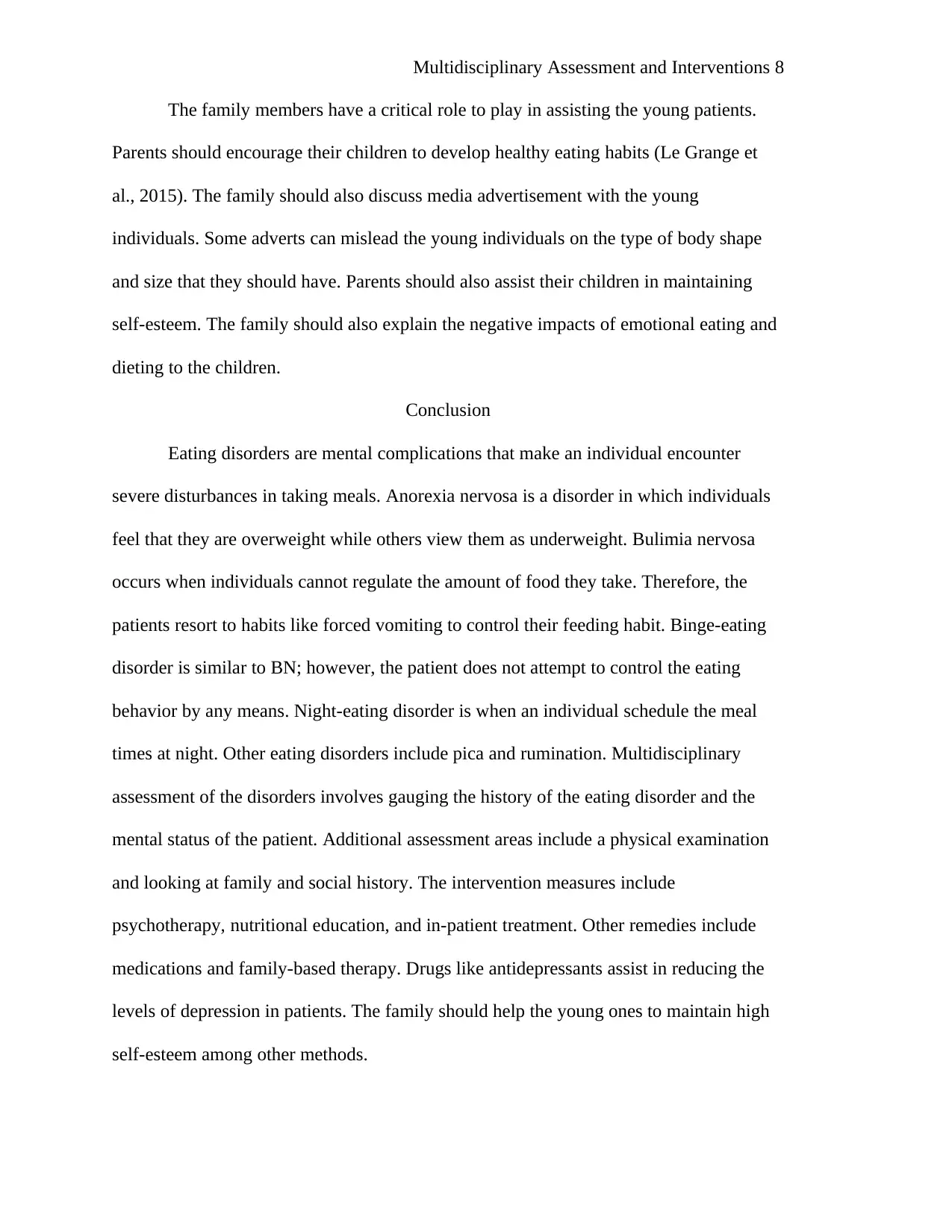
Multidisciplinary Assessment and Interventions 8
The family members have a critical role to play in assisting the young patients.
Parents should encourage their children to develop healthy eating habits (Le Grange et
al., 2015). The family should also discuss media advertisement with the young
individuals. Some adverts can mislead the young individuals on the type of body shape
and size that they should have. Parents should also assist their children in maintaining
self-esteem. The family should also explain the negative impacts of emotional eating and
dieting to the children.
Conclusion
Eating disorders are mental complications that make an individual encounter
severe disturbances in taking meals. Anorexia nervosa is a disorder in which individuals
feel that they are overweight while others view them as underweight. Bulimia nervosa
occurs when individuals cannot regulate the amount of food they take. Therefore, the
patients resort to habits like forced vomiting to control their feeding habit. Binge-eating
disorder is similar to BN; however, the patient does not attempt to control the eating
behavior by any means. Night-eating disorder is when an individual schedule the meal
times at night. Other eating disorders include pica and rumination. Multidisciplinary
assessment of the disorders involves gauging the history of the eating disorder and the
mental status of the patient. Additional assessment areas include a physical examination
and looking at family and social history. The intervention measures include
psychotherapy, nutritional education, and in-patient treatment. Other remedies include
medications and family-based therapy. Drugs like antidepressants assist in reducing the
levels of depression in patients. The family should help the young ones to maintain high
self-esteem among other methods.
The family members have a critical role to play in assisting the young patients.
Parents should encourage their children to develop healthy eating habits (Le Grange et
al., 2015). The family should also discuss media advertisement with the young
individuals. Some adverts can mislead the young individuals on the type of body shape
and size that they should have. Parents should also assist their children in maintaining
self-esteem. The family should also explain the negative impacts of emotional eating and
dieting to the children.
Conclusion
Eating disorders are mental complications that make an individual encounter
severe disturbances in taking meals. Anorexia nervosa is a disorder in which individuals
feel that they are overweight while others view them as underweight. Bulimia nervosa
occurs when individuals cannot regulate the amount of food they take. Therefore, the
patients resort to habits like forced vomiting to control their feeding habit. Binge-eating
disorder is similar to BN; however, the patient does not attempt to control the eating
behavior by any means. Night-eating disorder is when an individual schedule the meal
times at night. Other eating disorders include pica and rumination. Multidisciplinary
assessment of the disorders involves gauging the history of the eating disorder and the
mental status of the patient. Additional assessment areas include a physical examination
and looking at family and social history. The intervention measures include
psychotherapy, nutritional education, and in-patient treatment. Other remedies include
medications and family-based therapy. Drugs like antidepressants assist in reducing the
levels of depression in patients. The family should help the young ones to maintain high
self-esteem among other methods.
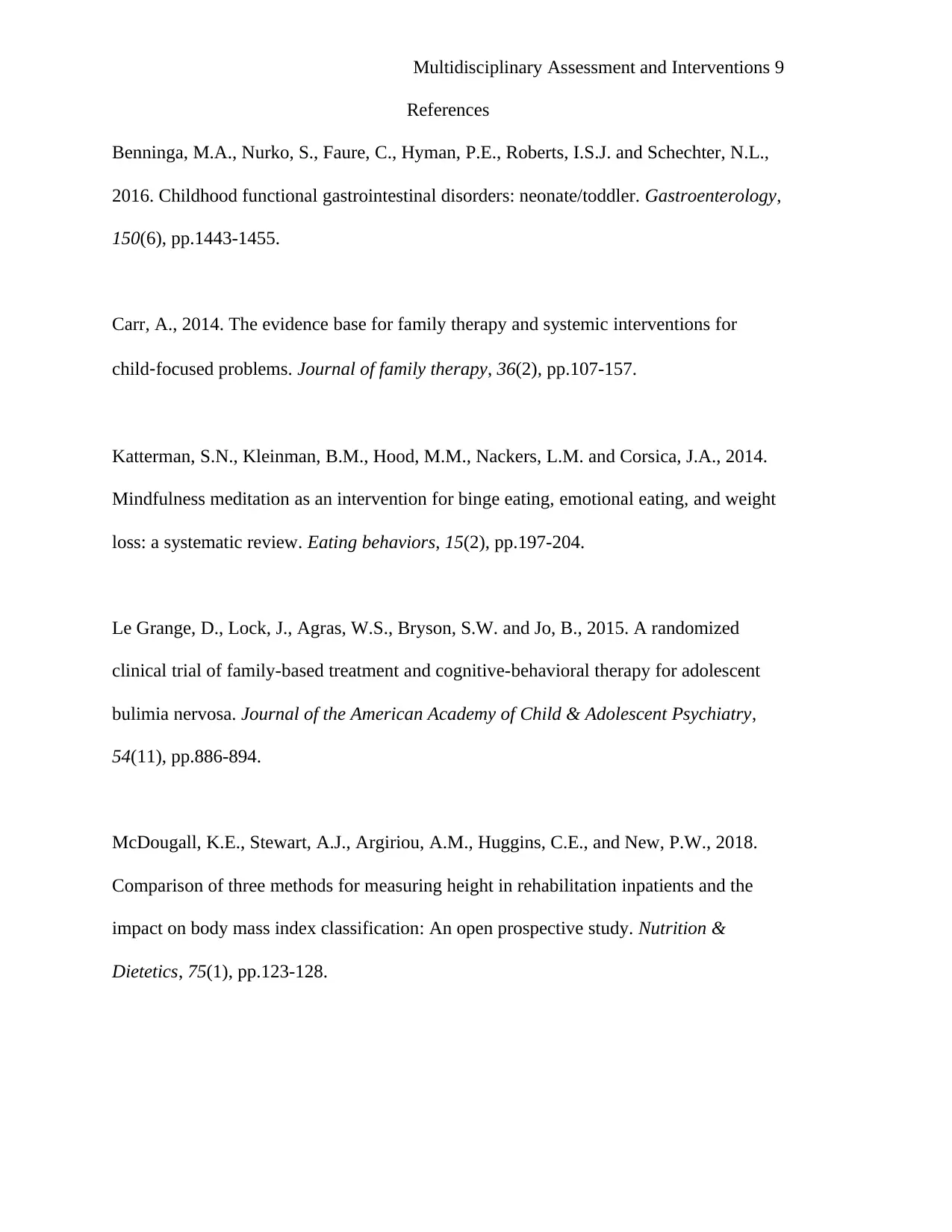
Multidisciplinary Assessment and Interventions 9
References
Benninga, M.A., Nurko, S., Faure, C., Hyman, P.E., Roberts, I.S.J. and Schechter, N.L.,
2016. Childhood functional gastrointestinal disorders: neonate/toddler. Gastroenterology,
150(6), pp.1443-1455.
Carr, A., 2014. The evidence base for family therapy and systemic interventions for
child‐focused problems. Journal of family therapy, 36(2), pp.107-157.
Katterman, S.N., Kleinman, B.M., Hood, M.M., Nackers, L.M. and Corsica, J.A., 2014.
Mindfulness meditation as an intervention for binge eating, emotional eating, and weight
loss: a systematic review. Eating behaviors, 15(2), pp.197-204.
Le Grange, D., Lock, J., Agras, W.S., Bryson, S.W. and Jo, B., 2015. A randomized
clinical trial of family-based treatment and cognitive-behavioral therapy for adolescent
bulimia nervosa. Journal of the American Academy of Child & Adolescent Psychiatry,
54(11), pp.886-894.
McDougall, K.E., Stewart, A.J., Argiriou, A.M., Huggins, C.E., and New, P.W., 2018.
Comparison of three methods for measuring height in rehabilitation inpatients and the
impact on body mass index classification: An open prospective study. Nutrition &
Dietetics, 75(1), pp.123-128.
References
Benninga, M.A., Nurko, S., Faure, C., Hyman, P.E., Roberts, I.S.J. and Schechter, N.L.,
2016. Childhood functional gastrointestinal disorders: neonate/toddler. Gastroenterology,
150(6), pp.1443-1455.
Carr, A., 2014. The evidence base for family therapy and systemic interventions for
child‐focused problems. Journal of family therapy, 36(2), pp.107-157.
Katterman, S.N., Kleinman, B.M., Hood, M.M., Nackers, L.M. and Corsica, J.A., 2014.
Mindfulness meditation as an intervention for binge eating, emotional eating, and weight
loss: a systematic review. Eating behaviors, 15(2), pp.197-204.
Le Grange, D., Lock, J., Agras, W.S., Bryson, S.W. and Jo, B., 2015. A randomized
clinical trial of family-based treatment and cognitive-behavioral therapy for adolescent
bulimia nervosa. Journal of the American Academy of Child & Adolescent Psychiatry,
54(11), pp.886-894.
McDougall, K.E., Stewart, A.J., Argiriou, A.M., Huggins, C.E., and New, P.W., 2018.
Comparison of three methods for measuring height in rehabilitation inpatients and the
impact on body mass index classification: An open prospective study. Nutrition &
Dietetics, 75(1), pp.123-128.
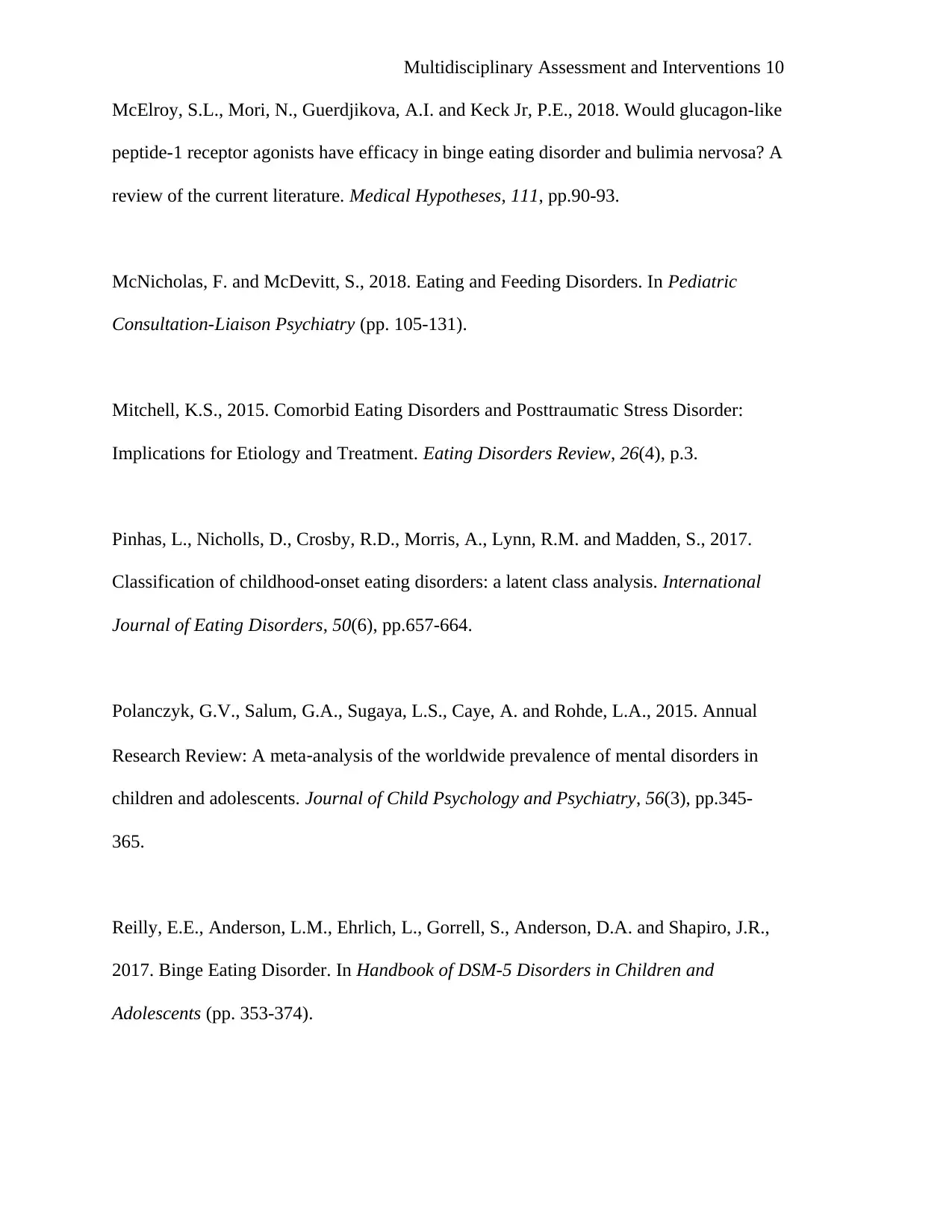
Multidisciplinary Assessment and Interventions 10
McElroy, S.L., Mori, N., Guerdjikova, A.I. and Keck Jr, P.E., 2018. Would glucagon-like
peptide-1 receptor agonists have efficacy in binge eating disorder and bulimia nervosa? A
review of the current literature. Medical Hypotheses, 111, pp.90-93.
McNicholas, F. and McDevitt, S., 2018. Eating and Feeding Disorders. In Pediatric
Consultation-Liaison Psychiatry (pp. 105-131).
Mitchell, K.S., 2015. Comorbid Eating Disorders and Posttraumatic Stress Disorder:
Implications for Etiology and Treatment. Eating Disorders Review, 26(4), p.3.
Pinhas, L., Nicholls, D., Crosby, R.D., Morris, A., Lynn, R.M. and Madden, S., 2017.
Classification of childhood-onset eating disorders: a latent class analysis. International
Journal of Eating Disorders, 50(6), pp.657-664.
Polanczyk, G.V., Salum, G.A., Sugaya, L.S., Caye, A. and Rohde, L.A., 2015. Annual
Research Review: A meta‐analysis of the worldwide prevalence of mental disorders in
children and adolescents. Journal of Child Psychology and Psychiatry, 56(3), pp.345-
365.
Reilly, E.E., Anderson, L.M., Ehrlich, L., Gorrell, S., Anderson, D.A. and Shapiro, J.R.,
2017. Binge Eating Disorder. In Handbook of DSM-5 Disorders in Children and
Adolescents (pp. 353-374).
McElroy, S.L., Mori, N., Guerdjikova, A.I. and Keck Jr, P.E., 2018. Would glucagon-like
peptide-1 receptor agonists have efficacy in binge eating disorder and bulimia nervosa? A
review of the current literature. Medical Hypotheses, 111, pp.90-93.
McNicholas, F. and McDevitt, S., 2018. Eating and Feeding Disorders. In Pediatric
Consultation-Liaison Psychiatry (pp. 105-131).
Mitchell, K.S., 2015. Comorbid Eating Disorders and Posttraumatic Stress Disorder:
Implications for Etiology and Treatment. Eating Disorders Review, 26(4), p.3.
Pinhas, L., Nicholls, D., Crosby, R.D., Morris, A., Lynn, R.M. and Madden, S., 2017.
Classification of childhood-onset eating disorders: a latent class analysis. International
Journal of Eating Disorders, 50(6), pp.657-664.
Polanczyk, G.V., Salum, G.A., Sugaya, L.S., Caye, A. and Rohde, L.A., 2015. Annual
Research Review: A meta‐analysis of the worldwide prevalence of mental disorders in
children and adolescents. Journal of Child Psychology and Psychiatry, 56(3), pp.345-
365.
Reilly, E.E., Anderson, L.M., Ehrlich, L., Gorrell, S., Anderson, D.A. and Shapiro, J.R.,
2017. Binge Eating Disorder. In Handbook of DSM-5 Disorders in Children and
Adolescents (pp. 353-374).
Paraphrase This Document
Need a fresh take? Get an instant paraphrase of this document with our AI Paraphraser
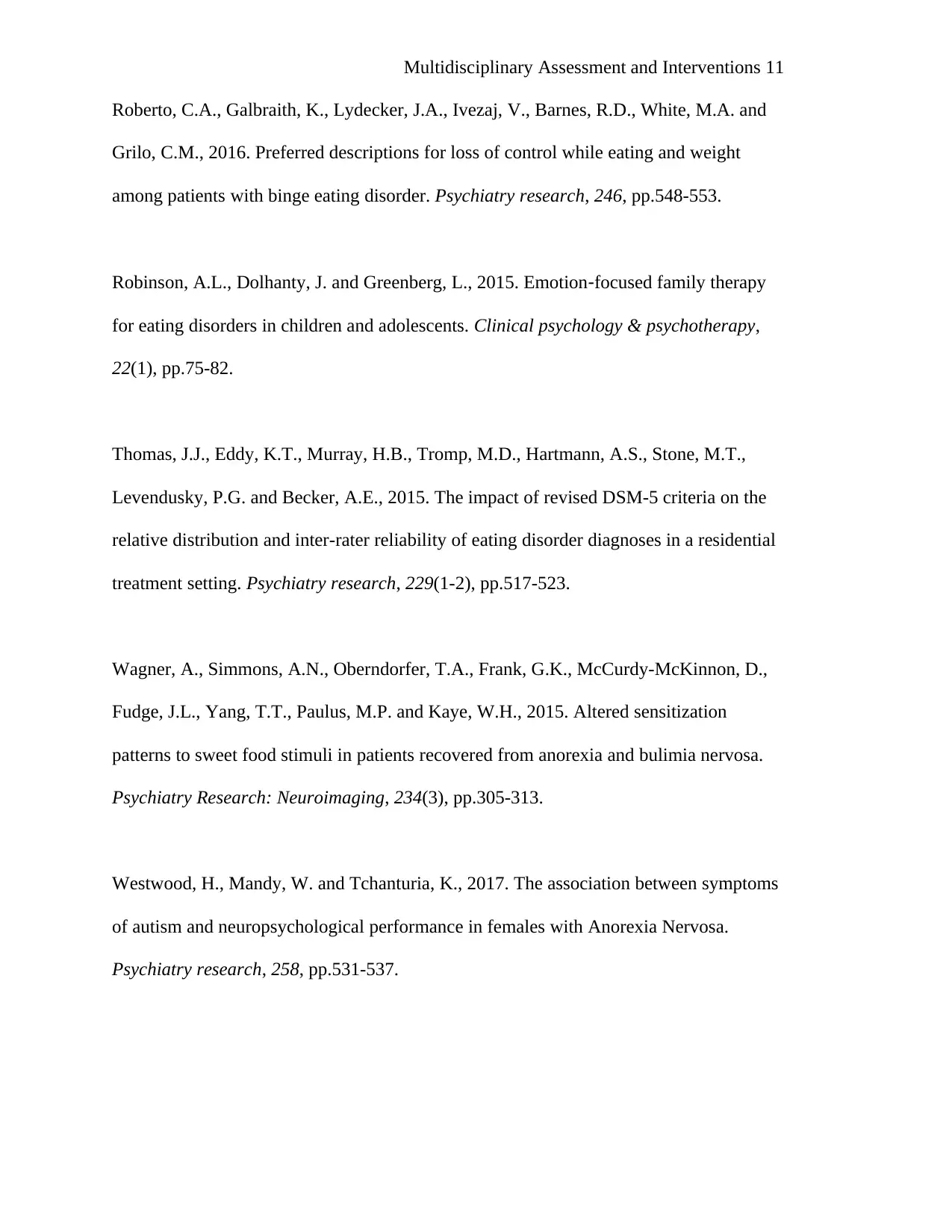
Multidisciplinary Assessment and Interventions 11
Roberto, C.A., Galbraith, K., Lydecker, J.A., Ivezaj, V., Barnes, R.D., White, M.A. and
Grilo, C.M., 2016. Preferred descriptions for loss of control while eating and weight
among patients with binge eating disorder. Psychiatry research, 246, pp.548-553.
Robinson, A.L., Dolhanty, J. and Greenberg, L., 2015. Emotion‐focused family therapy
for eating disorders in children and adolescents. Clinical psychology & psychotherapy,
22(1), pp.75-82.
Thomas, J.J., Eddy, K.T., Murray, H.B., Tromp, M.D., Hartmann, A.S., Stone, M.T.,
Levendusky, P.G. and Becker, A.E., 2015. The impact of revised DSM-5 criteria on the
relative distribution and inter-rater reliability of eating disorder diagnoses in a residential
treatment setting. Psychiatry research, 229(1-2), pp.517-523.
Wagner, A., Simmons, A.N., Oberndorfer, T.A., Frank, G.K., McCurdy-McKinnon, D.,
Fudge, J.L., Yang, T.T., Paulus, M.P. and Kaye, W.H., 2015. Altered sensitization
patterns to sweet food stimuli in patients recovered from anorexia and bulimia nervosa.
Psychiatry Research: Neuroimaging, 234(3), pp.305-313.
Westwood, H., Mandy, W. and Tchanturia, K., 2017. The association between symptoms
of autism and neuropsychological performance in females with Anorexia Nervosa.
Psychiatry research, 258, pp.531-537.
Roberto, C.A., Galbraith, K., Lydecker, J.A., Ivezaj, V., Barnes, R.D., White, M.A. and
Grilo, C.M., 2016. Preferred descriptions for loss of control while eating and weight
among patients with binge eating disorder. Psychiatry research, 246, pp.548-553.
Robinson, A.L., Dolhanty, J. and Greenberg, L., 2015. Emotion‐focused family therapy
for eating disorders in children and adolescents. Clinical psychology & psychotherapy,
22(1), pp.75-82.
Thomas, J.J., Eddy, K.T., Murray, H.B., Tromp, M.D., Hartmann, A.S., Stone, M.T.,
Levendusky, P.G. and Becker, A.E., 2015. The impact of revised DSM-5 criteria on the
relative distribution and inter-rater reliability of eating disorder diagnoses in a residential
treatment setting. Psychiatry research, 229(1-2), pp.517-523.
Wagner, A., Simmons, A.N., Oberndorfer, T.A., Frank, G.K., McCurdy-McKinnon, D.,
Fudge, J.L., Yang, T.T., Paulus, M.P. and Kaye, W.H., 2015. Altered sensitization
patterns to sweet food stimuli in patients recovered from anorexia and bulimia nervosa.
Psychiatry Research: Neuroimaging, 234(3), pp.305-313.
Westwood, H., Mandy, W. and Tchanturia, K., 2017. The association between symptoms
of autism and neuropsychological performance in females with Anorexia Nervosa.
Psychiatry research, 258, pp.531-537.
1 out of 11
Related Documents
Your All-in-One AI-Powered Toolkit for Academic Success.
+13062052269
info@desklib.com
Available 24*7 on WhatsApp / Email
![[object Object]](/_next/static/media/star-bottom.7253800d.svg)
Unlock your academic potential
© 2024 | Zucol Services PVT LTD | All rights reserved.





